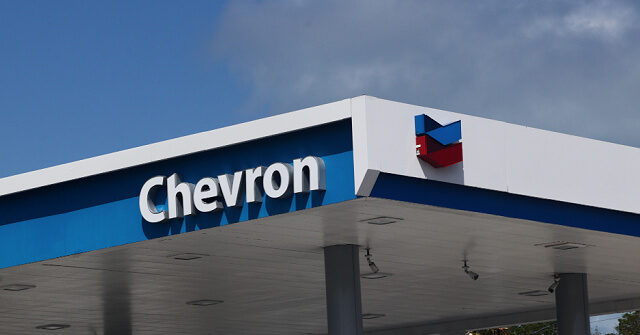Chevron on Monday announced a massive project, kicking off oil and natural gas production from the Ballymore subsea tieback in the Gulf of America, which is expected to produce upwards of 75,000 gross barrels of oil daily — another major move towards energy independence and dominance for the United States of America.
Ballymore — located in the Mississippi Canyon area — has been described as a “subsea tieback,” meaning the discovery can be leveraged by an existing platform, using three wells tied to the already-standing Chevron-operated Blind Faith facility.
A fact sheet provided to Breitbart News notes that this is far more efficient, as the project leverages “standardized equipment, repeatable engineering solutions, and existing transportation infrastructure.”
Along with the reality that Chevron strives to maintain “one of the lowest carbon intensity oil and natural gas basins in the world,” this will help Chevron with its goal of producing 300,000 net barrels of oil per day in the Gulf of America alone by 2026. If achieved, this would be a 50 percent increase from 2024 and position the country for one of its prime goals of reaching energy dominance in a growing and more demanding world.
As it stands, oil from the Gulf of America accounts for one out of every six barrels of domestic oil production. They estimate that Ballymore will be able to recover 150 million barrels of oil equivalent gross over the span of the project.
“Ballymore is an example of how we are leveraging technology and driving efficiencies to help produce affordable, reliable energy from the deepwater Gulf of America, one of the lowest carbon intensity oil and gas producing basins in the world,” Brent Gros, vice president of Chevron Gulf of America, said in a statement.
“Ballymore, which was completed on time and on budget, brings additional production online without building a new standalone offshore platform,” he continued. “This reduces our development costs and is expected to drive higher returns for shareholders.”
Chevron believes the Ballymore project showcases the company’s commitment to helping lower energy costs for Americans, utilizing its own resources in an efficient and responsible manner — in this case, by using a subsea tieback to connect to existing equipment and Chevron’s Blind Faith platform.
This massive announcement follows a few other major milestones highlighted by Chevron since President Donald Trump — who ran on the platform that included American energy dominance — won the presidential election. In November, Chevron announced that its Tahiti Field produced its 500 millionth barrel of oil-equivalent.
“The total production from the field is enough to power 11.5 million homes for one year,” the press release noted, putting this in further context.
Months later, in January, Chevron announced the beginning of oil production from the Whale semi-submersible platform in the Gulf of America.
“Production from Whale brings Chevron another step closer to reaching 300,000 net barrels of oil equivalent per day in the U.S. Gulf of Mexico by 2026,” Bruce Niemeyer, president of Chevron Americas Exploration & Production said in a statement at the time.
“As a leading leaseholder in the Gulf, where we produce some of the lowest carbon intensity oil and natural gas in the world, Chevron is well positioned to continue growing affordable, reliable production in the U.S. while delivering higher returns and cash flow,” he added.
In all, Chevron’s project aligns with the goals of the Trump administration in making American energy dominance a reality while also lowering energy costs for consumers.
Shortly after taking office in his second term, President Donald Trump signed an executive order establishing the National Energy Dominance Council, chaired by Secretary of the Interior Doug Burgum with Secretary of Energy Chris Wright serving as the vice chair.
The council is tasked with advising Trump on “strategies to achieve energy dominance by improving the processes for permitting, production, generation, distribution, regulation, and transportation across all forms of American energy.” It also includes working with stakeholders in both the private and public sector to “expand energy production and address cost barriers.”
“This is a big deal,” Trump said at the time. “We have more energy than any other country, and now we’re unleashing it, to put it nicely.”
Read the full article here
